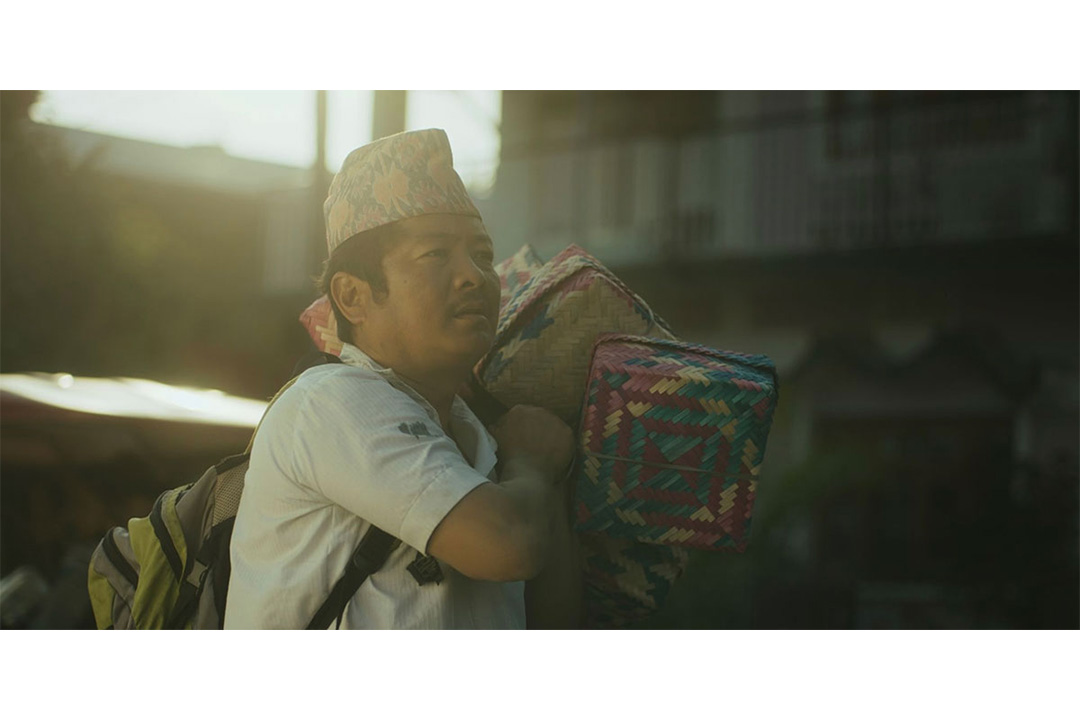A rickety bus on a precarious road wobbles along, bringing hope and novelty to the rural village inhabited by a Rai community. The residents of this Nepalese mountain village welcome the town bus like the Garuda, the mount of Lord Vishnu himself; they anoint the travellers with marigold garlands and grace the rear-view mirror of the bus with the same courtesy. But is modernity a false god?
Nabin Subba’s A Road to A Village portrays the impact of a road built in the village of Maila, a basket weaver, and his family. Maila’s basket-weaving skills are rendered useless for commerce when the bus begins to bring the wares of the city — plastic tarps in place of bamboo mats, plastic seats in place of woven ones — which leaves him urgently scrambling for a source of income to sustain his family.
His son, Bindrey, the apple of his father’s eye, is an imaginative but demanding child whose deepest wish is to have a television set, and it is Maila’s deepest wish to fulfill his son’s wishes. But a television set comes at a price much heavier than Maila could anticipate. We watch the basket weaver traverse this new modern terrain, engaging in odd jobs, like selling prohibited liquor, to make his son’s dream come true.
The cinematography in Road to a Village compellingly captures the vastness of Nepal’s rocky peaks compared to the minutiae of its human inhabitants and their relations. We see Maila and Bindrey on a hilltop overlooking the mountain range: two lone figures, father and son, shrunk in the face of the looming hills. They watch the coiling path that brought the false god of technology slither into the urban jungle of the city of Dharan — mapping the dreary path of their lives, and of ‘modernity.’
There is a recurring image of characters being shown in reflections: in water, glasses, and rearview mirrors. As Bindrey points out, these reflections make the villagers look like the “people inside the television.” The shot of Maila looking at himself in a large pond with a satellite dish lurking in the background is disturbed by a ripple in the pool, much like how the reality of his life is interrupted by the plasticity of the Coca-Cola commercials and swimsuit models on television.
The film begins with a good balance between the lightness of the father-son bond and the dreariness of their uncertain future, but near the end, the viewer finds themself jolted unexpectedly by a heartbreaking twist. Right after this twist, the film could have transitioned into Maila and his wife leaving the village. Instead, the emotional impact of the ending is slightly watered down by the scenes that transpire after.
Unfortunately, the film score sticks out sorely, especially in the more emotionally charged scenes. As Maila weeps at the tragic turn their life has taken, the dramatic music pulses and quickens, thumping louder than the heart of the film itself. In the film’s supposedly saddest moments, the score hushes the viewer’s sense of tragedy. After all, what could be more heart-wrenching than Maila’s howls echoing through the hills?
Actress Pushapti Rai captures the essence of a mother so well: she is tough with her love because she wants the best for her son. However, her powerful performance is imbued with a sense of melodrama, and it feels incongruous with the more realistic tone of the film.
Bindrey is an absolute joy; his precocious smile and luminous presence make almost every scene with him more joyful. In the scene where Bindrey runs after the bus calling for his father, his piteous cries sing a melody much more powerful than the musical score. It was a delight to watch a young talent deliver a comedic and poignant performance.
Director Subba excels in depicting the lightheartedness of family fights. Take, for instance, Bindrey’s fake sniffles at his mother’s taunt, just to have his father console him with Coca-Cola. Subba’s theatre background is also evident. In a scene where Bindrey mirthfully asks his parents as to why they are so boring, if not to provide him money to procure Coca-Cola, he positions Bindrey on a tall rock with his hand resting on his knee, resembling a king overlooking the peasants — his parents — working on the fields.
Road to a Village left me excited to see cinema reflecting different stories, such as the stories reflected in the silver bangles that Maila’s wife hopes to sell, in the pool reflecting Maila’s dreams, and in the eyeglasses that Bindrey engineers out of camera film.
I hope that the future of cinema leads us down more roads yet untravelled.



No comments to display.